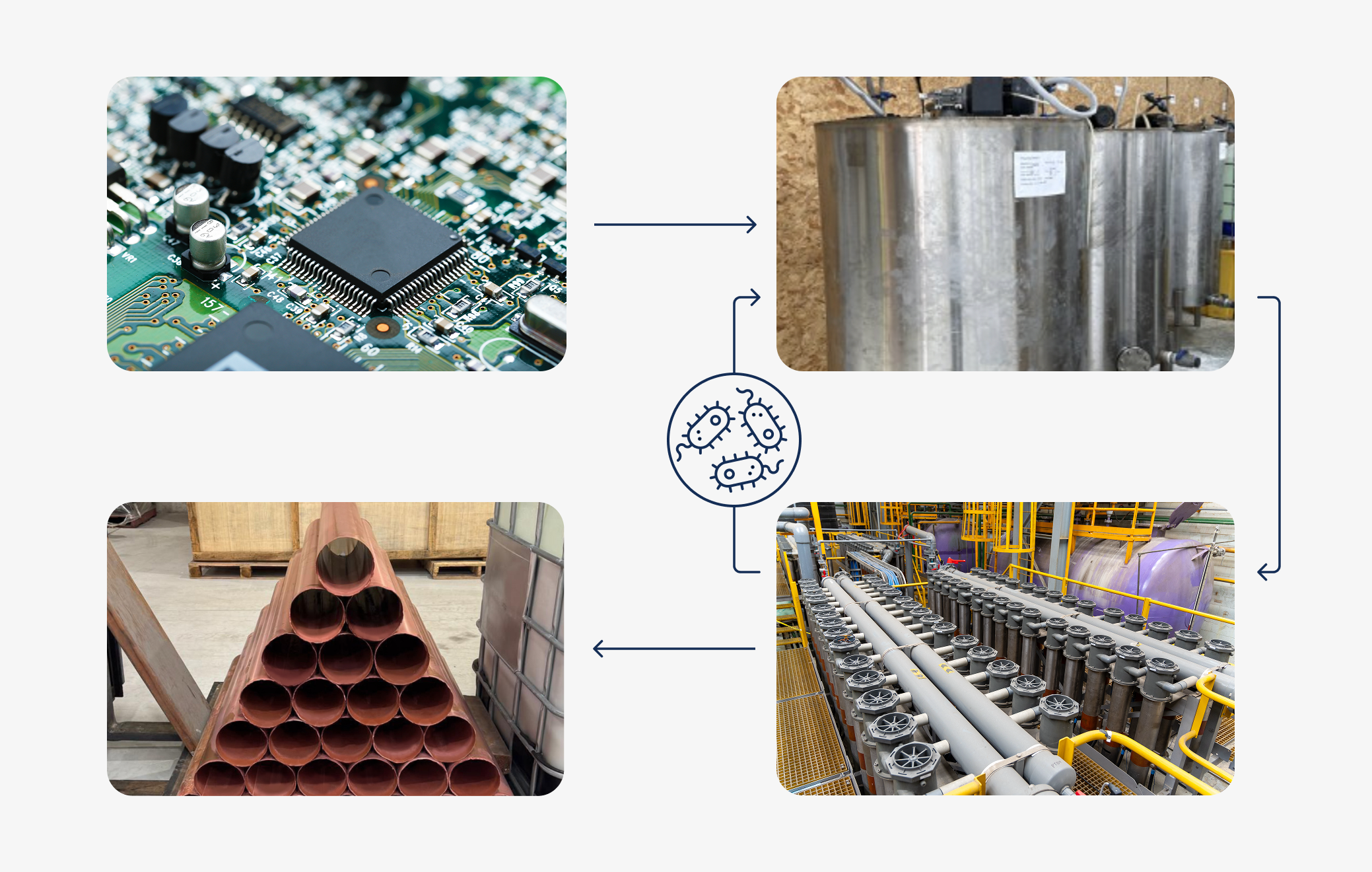The electrowinning of copper is an electrolytic process that uses electricity to recover dissolved copper from solution as copper plate, also known as ‘cathode’.
Cu2+(aq) + 2e- -->Cu(s) (E0 = +0.34V)
Copper easily dissolves in acids including sulphuric, nitric and hydrochloric. Recovering copper cathode from acidic sulphate solutions using electrowinning is a well-known and fairly straightforward process that has been in commercial use since the late 19th century.
The introduction of emew’s vortex electrowinning technology has further pushed the boundaries and applications of copper electrowinning. Owing to its positive reduction potential (E0 = +0.34V), copper is quite willing to accept electrons when an electrical current is applied. Coupled with the intrinsic high mass transfer of emew electrowinning, recovery of high purity copper from low-concentration, mixed-metal and contaminated feeds is possible.
Let’s take a closer look at some common applications of copper electrowinning.
Copper electrowinning for copper refineries
Electrolytic copper refineries have an inherent need to control copper concentrations in the tankhouse. The process of electrorefining copper involves an impure copper anode and an inert cathode. An electric current is applied across the anode and cathode which causes the copper to dissolve from the anode to be then plated onto the cathode as pure copper metal. The anodic dissolution of copper is faster than the cathodic deposition resulting in an overall increase in dissolved copper concentration over time. In order to control the copper concentration in the electrolyte within a defined range, copper refineries use electrowinning. Furthermore, the impurities present in the copper anode will also dissolve into the electrolyte that will build up over time unless they are purged. This purge or ‘bleed’ of impurities takes place in what is known as a ‘liberator’ cell. These liberator cells are simply copper electrowinning cells that are optimized in stages to control copper concentration and bleed impurities from the refinery electrolyte to ensure production of LME Grade A copper cathode.

Conventional copper electrowinning, although commonplace, is not efficient for the liberator process resulting in:
- Off-spec copper that has to be recycled resulting in high working capital or work in progress (WIP)
- Generation of carcinogenic acid mist and potential for lethal arsine gas
- Production of tertiary liberator sludge or liberator cake
Use of advanced copper electrowinning technologies such as emew result in significant benefits for copper refinery liberator circuits including:
- Production of high purity saleable copper cathode down to 1 g/L Cu
- Significant reduction in working capital or WIP
- No acid mist or fugitive gases like arsine as emew cells are completely enclosed
- Better impurity control
- By-product credits from recovery of Nickel cathode
Copper refineries are taking advantage of these benefits and retrofitting conventional copper liberator cells with advanced emew liberator cells. A recent example is Hindustan Copper Limited, a government of India enterprise that installed emew for copper and nickel recovery from refinery bleed streams.

Copper electrowinning for nonferrous metal recycling
Metal recycling is becoming increasingly important from the perspectives of both sustainability and economics. Metal recycling uses 85% less energy per kg of copper produced compared to primary production (i.e. mining) and has less impact on the environment1. Worldwide copper recycling saves 100 million MWh of electrical energy and 40 million tonnes of CO2 annually. Secondary metal processors and recyclers are taking a lead role in turning scrap and end-of-life materials into usable metal that can be re-introduced into the supply chain.
Nonferrous metal recycling typically involves the following 5 steps:
- Collection
- Pre-processing and sorting
- Crushing and shredding
- Physical separation
- Pyro- or hydro-metallurgical processing
Depending on the recycling facility, these steps can happen all at same location, or at several locations. Once the end-of-life materials have been collected, sorted, crushed and shredded, the various components (glass, plastics, ferrous, nonferrous) can be separated based on physical properties such as specific gravity and magnetism. Copper and copper alloys will end up in the nonferrous fraction that can either be refined in a furnace (i.e. pyrometallurgy) or dissolved into a conductive electrolyte like sulphuric acid and electrowon (i.e. hydrometallurgy).
Selective leaching techniques can be used to separate the precious metals (gold, silver, platinum, palladium, etc) from the so-called base metals (copper, nickel, tin, etc) in the nonferrous fraction. A combination of direct electrowinning and other hydrometallurgical methods such as ion exchange (IX) and selective precipitation can then be used to separate and purify the individual metals. Copper can be directly electrowon using emew electrowinning from a sulphuric acid electrolyte prepared from the nonferrous fraction to produce pure copper cathode.
Copper electrowinning for waste recovery and wastewater treatment
Most governments and their regulatory agencies have defined limits for discharge of wastes. In order to comply with these increasingly stringent discharge limits as well as self-imposed sustainability targets, many companies are implementing ‘zero discharge’ policies. This means that all wastes and wastewaters generated are either recycled internally within the operation where they are produced, or further processed to an extent that they are no longer harmful. Unfortunately, this can result in low-grade, complex by-products that are either low-value or must be disposed of by a waste contractor. By-products that are ‘low-value’ are often difficult to reprocess by conventional means and hence the options are limited.

This is where advanced technologies like emew electrowinning can be used to recover metals such as copper from wastewater and waste residues. Copper can be directly electrowon from wastewater produced from plating facilities, semiconductor fabricators, refineries, recycling facilities, and so on. The result is production of a high purity copper cathode that can be sold to offset processing costs, and a de-copperized solution (<50ppm copper) that can be routinely treated using an existing effluent treatment plant (ETP). In some cases, the savings from not having to pay for hazardous waste disposal can pay for an onsite copper electrowinning system in a few months.
Waste residues, flue dusts, slags and so on are often complex, low-grade mixtures of metals that can be digested in a conductive electrolyte (such as sulphuric acid) so that the metal values can be recovered. For example, low grade residues containing only a few percent copper can be further processed to electrowin the copper as high purity cathode. Other metals such as gold, silver, lead, tin, cadmium, and nickel can also be recovered along with the copper using electrowinning or a combination of hydrometallurgical techniques.
Summary
Copper electrowinning has evolved considerably since its discovery in 1807. Today copper electrowinning is used in a variety of applications from controlling copper and impurities in a copper electrorefinery, to recovering copper down to ppm levels in semiconductor wastewater. Although the applications and objectives may be vast and varied, the fundamentals of copper electrowinning are the same, and advanced electrowinning systems such as emew will continue to push the limits of this robust technology.
References
1. European Copper Institute. (n.d.). Recycling Saves Energy and CO2. Retrieved from https://copperalliance.eu/benefits-of-copper/recycling/






